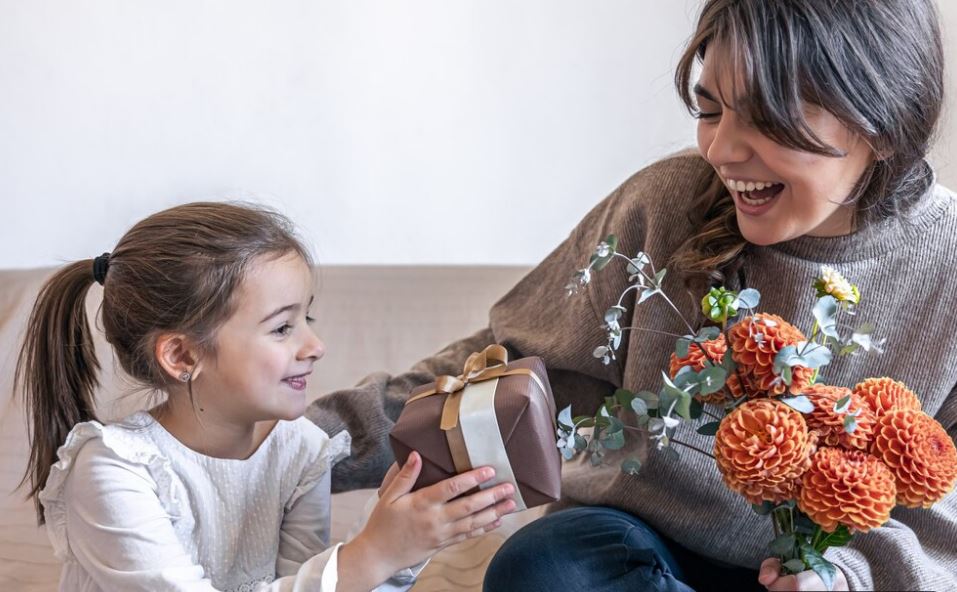
The most cherished Mother’s Day presents aren’t found online, but rather are created at the kitchen table, smeared with glue and glitter, and presented with a smile too big to fake in an era increasingly dominated by digital convenience and overnight delivery. These presents have a certain magic that cannot be produced, even though they are frequently made by tiny hands and even smaller attention spans.
Simple crafts like bath salt jars or handprint bouquets allow kids to create memories rather than just tangible items. Carefully put together and joyfully displayed, these mementos become emotional time capsules that resemble photographs but are layered with effort, texture, and fragrance. They provide mothers with a reflection of love that is unadulterated by perfection or price tags, which is far more valuable than beauty.
Homemade Gift Ideas for Mother’s Day
| DIY Gift Idea | Materials Needed | Why It’s Meaningful |
|---|---|---|
| Handprint Flower Art | Paint, cardstock, markers | Captures a child’s growth in a physical, framed form |
| Mason Jar Memory Notes | Jar, paper strips, twine, pen | A collection of heartfelt thoughts she can revisit year-round |
| Coffee Filter Flowers | Coffee filters, markers, spray bottle, pipe cleaners | Remarkably colorful and surprisingly durable paper florals |
| Clay Jewelry Dish | Air-dry clay, acrylic paint, sealant | Functional and sentimental—crafted with tiny hands |
| Homemade Bath Salts | Epsom salt, essential oils, food coloring, small jar | Particularly beneficial for moms needing a moment of calm |
| Button Bouquet | Buttons, craft wire, tape, repurposed vase | Cheerful, creative, and refreshingly unique |
| DIY Picture Frame | Popsicle sticks, glue, paint, printed family photo | Frames a moment she’ll return to over and over again |
| Fingerprint Heart Card | Cardstock, ink pads or water-based paint | Emotionally resonant through minimalism and texture |
| Teacup Candle | Wax flakes, wick, vintage teacup, scent oils | Incredibly versatile and endlessly charming |
| Custom Wrapping Paper | Bubble wrap, tempera paint, butcher paper | Fun for kids to make and deeply personal in presentation |
Love in All Layers: The Argument in Favor of Making Rather than Purchasing
Handmade goods are particularly noteworthy in the context of meaningful gift-giving—not because they are flawless, but rather because they are incredibly intimate. Children naturally show affection through tactile expressions during the crafting process, such as scribbles, brushstrokes, and bows that aren’t tied perfectly. Despite their low material cost, these objects grow into family heirlooms that silently occupy hearts, shelves, and drawers.
In the last ten years, hands-on crafting has gained popularity among parents and educators as a developmental tool as well as a hobby. Children are also developing emotional awareness, patience, and a sense of accomplishment when they are guided through creative projects. Incorporating this practice into school programs not only significantly improves engagement but also makes it much more effective.
Anecdotal Snapshot: A Present That Was More Than Just Shiny
Consider Olivia, a Hobart mother of three, who continues to have a crayon-colored portrait of herself taped inside a wardrobe door. She laughs, “He drew me with three arms and purple hair.” “However, it read ‘Best Mom Ever’ underneath, and to be honest, no present has ever surpassed it since.”
Despite being personal, this story is remarkably similar to countless others. Mothers find unparalleled authenticity—an unvarnished, unedited reminder of being loved—in these flawed but emotionally impactful gifts.
The Greater Gift: Disguised Emotional Intelligence
Children unknowingly develop lifelong emotional skills by working on these meaningful projects. They’re learning to give without expecting anything in return, think about relationships, and express gratitude. As they mature, these traits—which were subtly fostered with glue and glitter—translate into kindness, empathy, and confidence.
Child-led craft sessions have been especially creative in fostering inclusive, multisensory learning environments through strategic inclusion in classrooms. Every activity strengthens emotional ties and improves motor skills, whether it’s making button flowers or weaving yarn through paper hearts.
Leading the Craft: How to Keep It Easy But Unique
- Put Simplicity First: When projects involve simple tools and well-known supplies like yarn, buttons, and construction paper, kids are more engaged for longer.
- Promote Ownership: Let children take the lead, even if there is too much glue or the colors don’t go well together. Aesthetics are never as important as authenticity.
- Accept the Mess: The process is just as important to crafting as the final product. For a memento mom will treasure, a little glitter in the carpet is worth it.
- Utilize Homemade Materials: Many of the greatest crafts begin with materials that are already in your home, such as mason jars or egg cartons.
- Add Words: Invite children to write a poem or a note. Words frequently strike the deepest chords, especially when spoken by young voices.
A Mother’s Day Present That Doubles
Extravagance is not necessary for Mother’s Day to have significance. Families can create a shared experience rather than a gift with a few hours, a child’s imagination, and a little creative mess. One of the memories.
Because a handmade fingerprint flower or a shaky “I love you” written in felt-tip marker are more romantic than any store-bought bouquet. These presents are tangible manifestations of love. Mothers ultimately remember that very thing—not the accuracy, but the presence.
